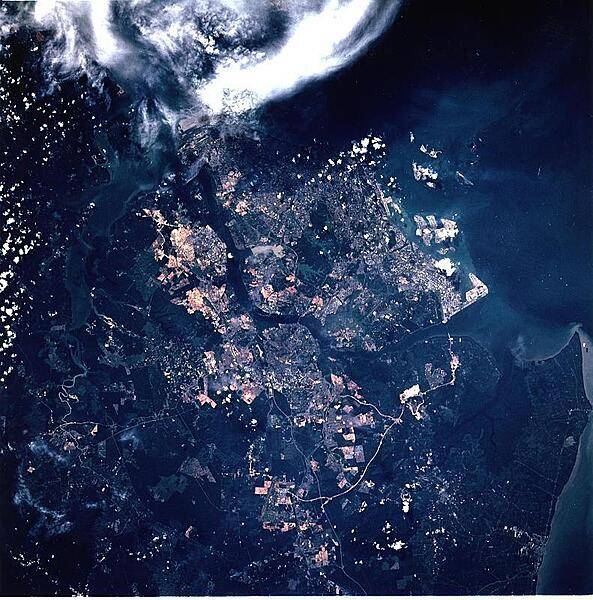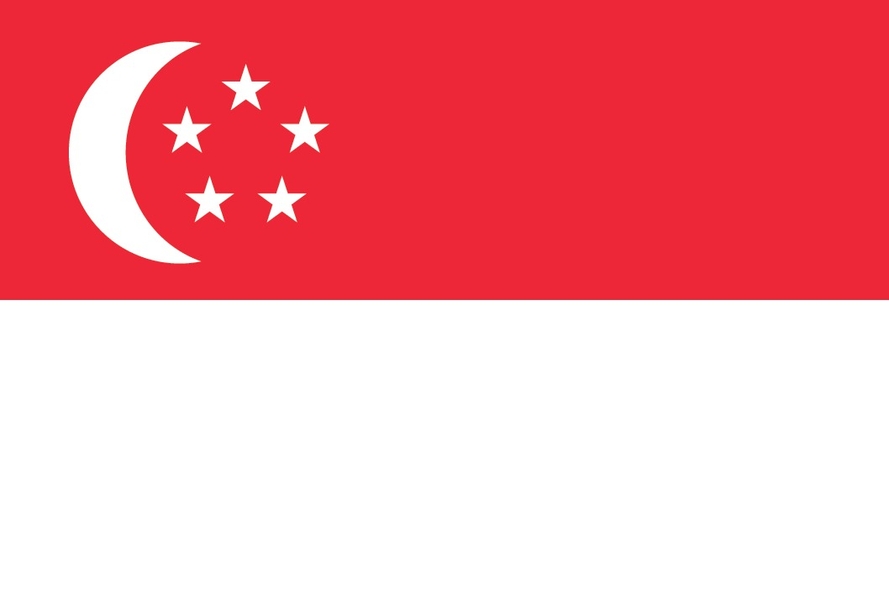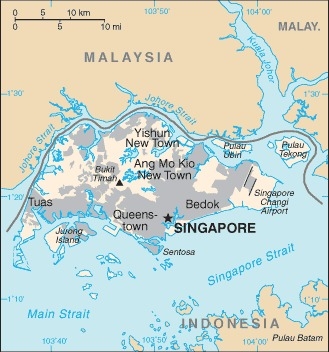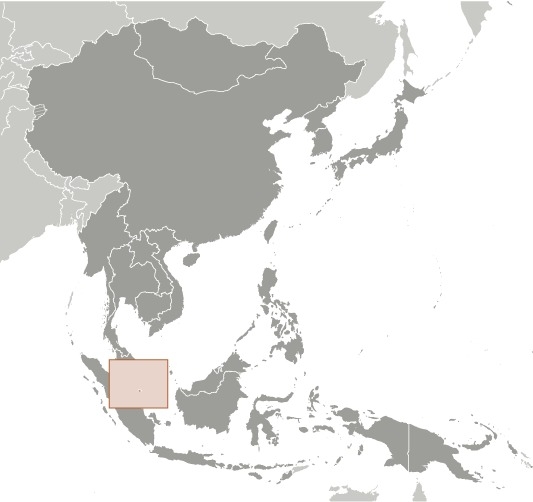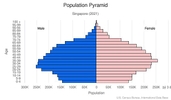Introduction
Background
A Malay trading port known as Temasek existed on the island of Singapore by the 14th century. The settlement changed hands several times in the ensuing centuries and was eventually burned in the 17th century and fell into obscurity. The British founded modern Singapore as a trading colony on the site in 1819. It joined the Malaysian Federation in 1963 but was ousted two years later and became independent. Singapore subsequently became one of the world's most prosperous countries with strong international trading links (its port is one of the world's busiest in terms of tonnage handled) and with per capita GDP equal to that of the leading nations of Western Europe.
Visit the Definitions and Notes page to view a description of each topic.
Geography
Location
Southeastern Asia, islands between Malaysia and Indonesia
Geographic coordinates
1 22 N, 103 48 E
Map references
Southeast Asia
Land boundaries
total: 0 km
Coastline
193 km
Maritime claims
territorial sea: 3 nm
exclusive fishing zone: within and beyond territorial sea, as defined in treaties and practice
Climate
tropical; hot, humid, rainy; two distinct monsoon seasons - northeastern monsoon (December to March) and southwestern monsoon (June to September); inter-monsoon - frequent afternoon and early evening thunderstorms
Terrain
lowlying, gently undulating central plateau
Elevation
highest point: Bukit Timah 166 m
lowest point: Singapore Strait 0 m
Natural resources
fish, deepwater ports
Land use
agricultural land: 1% (2018 est.)
arable land: 0.9% (2018 est.)
permanent crops: 0.1% (2018 est.)
permanent pasture: 0% (2018 est.)
forest: 3.3% (2018 est.)
other: 95.7% (2018 est.)
Irrigated land
0 sq km (2012)
Population distribution
most of the urbanization is along the southern coast, with relatively dense population clusters found in the central areas
Natural hazards
flash floods
Geography - note
focal point for Southeast Asian sea routes; consists of about 60 islands, by far the largest of which is Pulau Ujong; land reclamation has removed many former islands and created a number of new ones
People and Society
Nationality
noun: Singaporean(s)
adjective: Singapore
Ethnic groups
Chinese 74.3%, Malay 13.5%, Indian 9%, other 3.2% (2020 est.)
note: data represent population by self-identification; the population is divided into four categories: Chinese, Malay (includes indigenous Malays and Indonesians), Indian (includes Indian, Pakistani, Bangladeshi, or Sri Lankan), and other ethnic groups (includes Eurasians, Caucasians, Japanese, Filipino, Vietnamese)
Languages
English (official) 48.3%, Mandarin (official) 29.9%, other Chinese dialects (includes Hokkien, Cantonese, Teochew, Hakka) 8.7%, Malay (official) 9.2%, Tamil (official) 2.5%, other 1.4%; note - data represent language most frequently spoken at home (2020 est.)
major-language sample(s):
The World Factbook, the indispensable source for basic information. (English)
世界概況 – 不可缺少的基本消息來源 (Mandarin)
Religions
Buddhist 31.1%, Christian 18.9%, Muslim 15.6%, Taoist 8.8%, Hindu 5%, other 0.6%, none 20% (2020 est.)
Demographic profile
Singapore has one of the lowest total fertility rates (TFR) in the world – an average of 1.15 children born per woman – and a rapidly aging population. Women’s expanded educations, widened aspirations, and a desire to establish careers has contributed to delayed marriage and smaller families. Most married couples have only one or two children in order to invest more in each child, including the high costs of education. In addition, more and more Singaporeans, particularly women, are staying single. Factors contributing to this trend are a focus on careers, long working hours, the high cost of living, and long waits for public housing. With fertility at such a low rate and rising life expectancy, the proportion of the population aged 65 or over is growing and the youth population is shrinking. Singapore is projected to experience one of the largest percentage point increases in the elderly share of the population at 21% between 2019 and 2050, according to the UN. The working-age population (aged 15-64) will gradually decrease, leaving fewer workers to economically support the elderly population.
Migration has played a key role in Singapore’s development. As Singapore’s economy expanded during the 19th century, more and more Chinese, Indian, and Malay labor immigrants arrived. Most of Singapore’s pre-World War II population growth was a result of immigration. During World War II, immigration came to a halt when the Japanese occupied the island but revived in the postwar years. Policy was restrictive during the 1950s and 1960s, aiming to protect jobs for residents by reducing the intake of low-skilled foreign workers and focusing instead on attracting professionals from abroad with specialist skills. Consequently, the nonresident share of Singapore’s population plummeted to less than 3%.
As the country industrialized, however, it loosened restrictions on the immigration of manual workers. From the 1980s through the 2000s, the foreign population continued to grow as a result of policies aimed at attracting foreign workers of all skill levels. More recently, the government has instituted immigration policies that target highly skilled workers. Skilled workers are encouraged to stay and are given the opportunity to become permanent residents or citizens. The country, however, imposes restrictions on unskilled and low-skilled workers to ensure they do not establish roots, including prohibiting them from bringing their families and requiring employers to pay a monthly foreign worker levy and security bond. The country has also become increasingly attractive to international students. The growth of the foreign-born population has continued to be rapid; as of 2015, the foreign-born composed 46% of the total population. At the same time, growing numbers of Singaporeans are emigrating for education and work experience in highly skilled sectors such finance, information technology, and medicine. Increasingly, the moves abroad are permanent.
Age structure
0-14 years: 12.8% (male 406,983/female 387,665)
15-24 years: 15.01% (male 457,190/female 474,676)
25-54 years: 50.73% (male 1,531,088/female 1,618,844)
55-64 years: 10.58% (male 328,024/female 328,808)
65 years and over: 10.89% (male 310,123/female 366,259) (2020 est.)
Dependency ratios
total dependency ratio: 34.5
youth dependency ratio: 16.5
elderly dependency ratio: 18
potential support ratio: 5.6 (2020 est.)
Median age
total: 35.6 years
male: 35.4 years
female: 35.7 years (2020 est.)
Population distribution
most of the urbanization is along the southern coast, with relatively dense population clusters found in the central areas
Urbanization
urban population: 100% of total population (2021)
rate of urbanization: 0.74% annual rate of change (2020-25 est.)
Major urban areas - population
5.992 million SINGAPORE (capital) (2021)
Sex ratio
at birth: 1.07 male(s)/female
0-14 years: 1.05 male(s)/female
15-24 years: 0.96 male(s)/female
25-54 years: 0.95 male(s)/female
55-64 years: 1 male(s)/female
65 years and over: 0.85 male(s)/female
total population: 0.96 male(s)/female (2020 est.)
Mother's mean age at first birth
30.5 years (2015 est.)
median age
Maternal mortality ratio
8 deaths/100,000 live births (2017 est.)
country comparison to the world: 153Infant mortality rate
total: 1.56 deaths/1,000 live births
male: 1.72 deaths/1,000 live births
female: 1.4 deaths/1,000 live births (2021 est.)
Life expectancy at birth
total population: 86.19 years
male: 83.48 years
female: 89.05 years (2021 est.)
Drinking water source
improved: urban: 100% of population
total: 100% of population
unimproved: urban: 0% of population
total: 0% of population (2017 est.)
Current Health Expenditure
4.5% (2018)
Physicians density
2.29 physicians/1,000 population (2016)
Hospital bed density
2.5 beds/1,000 population (2017)
Sanitation facility access
improved: urban: 100% of population
total: 100% of population
unimproved: urban: 0% of population
total: 0% of population (2017 est.)
HIV/AIDS - people living with HIV/AIDS
8,000 (2020 est.)
note: estimate does not include children
HIV/AIDS - deaths
<100 (2020 est.)
note: estimate does not include children
Literacy
definition: age 15 and over can read and write
total population: 97.5%
male: 98.9%
female: 96.1% (2019)
School life expectancy (primary to tertiary education)
total: 17 years
male: 16 years
female: 17 years (2019)
Unemployment, youth ages 15-24
total: 10.6%
male: 8.1%
female: 13.5% (2020 est.)
Environment
Environment - current issues
water pollution; industrial pollution; limited natural freshwater resources; limited land availability presents waste disposal problems; air pollution; deforestation; seasonal smoke/haze resulting from forest fires in Indonesia
Environment - international agreements
party to: Biodiversity, Climate Change, Climate Change-Kyoto Protocol, Climate Change-Paris Agreement, Comprehensive Nuclear Test Ban, Desertification, Endangered Species, Hazardous Wastes, Law of the Sea, Nuclear Test Ban, Ozone Layer Protection, Ship Pollution
signed, but not ratified: none of the selected agreements
Air pollutants
particulate matter emissions: 18.26 micrograms per cubic meter (2016 est.)
carbon dioxide emissions: 37.54 megatons (2016 est.)
methane emissions: 4.4 megatons (2020 est.)
Climate
tropical; hot, humid, rainy; two distinct monsoon seasons - northeastern monsoon (December to March) and southwestern monsoon (June to September); inter-monsoon - frequent afternoon and early evening thunderstorms
Land use
agricultural land: 1% (2018 est.)
arable land: 0.9% (2018 est.)
permanent crops: 0.1% (2018 est.)
permanent pasture: 0% (2018 est.)
forest: 3.3% (2018 est.)
other: 95.7% (2018 est.)
Urbanization
urban population: 100% of total population (2021)
rate of urbanization: 0.74% annual rate of change (2020-25 est.)
Revenue from forest resources
forest revenues: 0% of GDP (2018 est.)
country comparison to the world: 197Waste and recycling
municipal solid waste generated annually: 7,704,300 tons (2017 est.)
municipal solid waste recycled annually: 4,699,623 tons (2015 est.)
percent of municipal solid waste recycled: 61% (2015 est.)
Total water withdrawal
municipal: 296.73 million cubic meters (2017 est.)
industrial: 336.294 million cubic meters (2017 est.)
agricultural: 26.376 million cubic meters (2017 est.)
Total renewable water resources
600 million cubic meters (2017 est.)
Government
Country name
conventional long form: Republic of Singapore
conventional short form: Singapore
local long form: Republic of Singapore
local short form: Singapore
etymology: name derives from the Sanskrit words "simha" (lion) and "pura" (city) to describe the city-state's leonine symbol
Government type
parliamentary republic
Capital
name: Singapore
geographic coordinates: 1 17 N, 103 51 E
time difference: UTC+8 (13 hours ahead of Washington, DC, during Standard Time)
etymology: name derives from the Sanskrit words "simha" (lion) and "pura" (city), thus creating the city's epithet "lion city"
Administrative divisions
no first order administrative divisions; there are five community development councils: Central Singapore Development Council, North East Development Council, North West Development Council, South East Development Council, South West Development Council (2019)
Independence
9 August 1965 (from Malaysian Federation)
National holiday
National Day, 9 August (1965)
Constitution
history: several previous; latest adopted 22 December 1965
amendments: proposed by Parliament; passage requires two-thirds majority vote in the second and third readings by the elected Parliament membership and assent of the president of the republic; passage of amendments affecting sovereignty or control of the Police Force or the Armed Forces requires at least two-thirds majority vote in a referendum; amended many times, last in 2020
Legal system
English common law
International law organization participation
has not submitted an ICJ jurisdiction declaration; non-party state to the ICC (2019)
Citizenship
citizenship by birth: no
citizenship by descent only: at least one parent must be a citizen of Singapore
dual citizenship recognized: no
residency requirement for naturalization: 10 years
Suffrage
21 years of age; universal and compulsory
Executive branch
chief of state: President HALIMAH Yacob (since 14 September 2017)
head of government: Prime Minister LEE Hsien Loong (since 12 August 2004, reelected 10 July 2020); Deputy Prime Ministers HENG Swee Keat (since 1 May 2019) (2019)
cabinet: Cabinet appointed by the president on the advice of the prime minister; Cabinet responsible to Parliament
elections/appointments: president directly elected by simple majority popular vote for a fixed term of 6-years (there are no term limits); election last held on 13 September 2017 (next to be held in 2023); following legislative elections, leader of majority party or majority coalition appointed prime minister by president; deputy prime ministers appointed by the president
election results: HALIMAH Yacob was declared president on 13 September 2017, being the only eligible candidate; Tony TAN Keng Yam elected president in the previous contested election on 27 August 2011; percent of vote - Tony TAN Keng Yam (independent) 35.2% , TAN Cheng Bock (independent) 34.9%, TAN Jee Say (independent) 25%, TAN Kin Lian (independent) 4.9%
Legislative branch
description: unicameral Parliament (104 seats; 93 members directly elected by popular vote, up to 9 nominated by a parliamentary selection committee and appointed by the president, and up to 12 non-constituency members from opposition parties to ensure political diversity; members serve 5-year terms); note - the number of nominated members increased to 12 for the 2020 election for the first time (2021)
elections: last held on 10 July 2020 (next must be held by 2025)
election results: percent of vote by party - PAP 61.2%, WP 11.2%, PSP 10.2%; seats by party - PAP 83, WP 10, PSP 2; composition - men 79, women 25, percent of women 24%
Judicial branch
highest courts: Supreme Court (although the number of judges varies - as of April 2019, the court totaled 20 judges, 7 judicial commissioners, 4 judges of appeal, and 16 international judges); the court is organized into an upper tier Appeal Court and a lower tier High Court
judge selection and term of office: judges appointed by the president from candidates recommended by the prime minister after consultation with the chief justice; judges usually serve until retirement at age 65, but terms can be extended
subordinate courts: district, magistrates', juvenile, family, community, and coroners' courts; small claims tribunals; employment claims tribunals
Political parties and leaders
National Solidarity Party or NSP [Spencer NG]
People's Action Party or PAP [LEE Hsien Loong]
People's Power Party or (PPP) [Goh Meng SENG]
People's Voice or PV [Lim TEAN]
Progress Singapore Party or PSP [Francis YUENT]
Red Dot United or RDU [Ravi PHILEMON]
Reform Party or RP [Kenneth JEYARETNAM]
Singapore Democratic Alliance or SDA [Abu MOHAMED]
Singapore Democratic Party or SDP [Dr. CHEE Soon Juan]
Singapore People's Party or SPP [Steve Chia]
Workers' Party or WP [Pritam SINGH] (2021)
International organization participation
ADB, AOSIS, APEC, Arctic Council (observer), ARF, ASEAN, BIS, C, CP, EAS, FAO, FATF, G-77, IAEA, IBRD, ICAO, ICC (national committees), ICCt, ICRM, IDA, IFC, IFRCS, IHO, ILO, IMF, IMO, IMSO, Interpol, IOC, IPU, ISO, ITSO, ITU, ITUC (NGOs), MIGA, NAM, OPCW, Pacific Alliance (observer), PCA, UN, UNCTAD, UNESCO, UNHCR, UPU, WCO, WHO, WIPO, WMO, WTO
Diplomatic representation in the US
chief of mission: Ambassador Ashok KUMAR Mirpuri (since 30 July 2012)
chancery: 3501 International Place NW, Washington, DC 20008
telephone: [1] (202) 537-3100
FAX: [1] (202) 537-0876
email address and website:
singemb_was@mfa.sg
https://www.mfa.gov.sg/washington/
consulate(s) general: San Francisco
consulate(s): New York
Diplomatic representation from the US
chief of mission: Ambassador Jonathan KAPLAN (since December 2021)
embassy: 27 Napier Road, Singapore 258508
mailing address: 4280 Singapore Place, Washington DC 20521-4280
telephone: [65] 6476-9100
FAX: [65] 6476-9340
email address and website:
singaporeusembassy@state.gov
https://sg.usembassy.gov/
Flag description
two equal horizontal bands of red (top) and white; near the hoist side of the red band, there is a vertical, white crescent (closed portion is toward the hoist side) partially enclosing five white five-pointed stars arranged in a circle; red denotes brotherhood and equality; white signifies purity and virtue; the waxing crescent moon symbolizes a young nation on the ascendancy; the five stars represent the nation's ideals of democracy, peace, progress, justice, and equality
National symbol(s)
lion, merlion (mythical half lion-half fish creature), orchid; national colors: red, white
National anthem
name: "Majulah Singapura" (Onward Singapore)
lyrics/music: ZUBIR Said
note: adopted 1965; first performed in 1958 at the Victoria Theatre, the anthem is sung only in Malay
Economy
Economic overview
Singapore has a highly developed and successful free-market economy. It enjoys an open and corruption-free environment, stable prices, and a per capita GDP higher than that of most developed countries. Unemployment is very low. The economy depends heavily on exports, particularly of electronics, petroleum products, chemicals, medical and optical devices, pharmaceuticals, and on Singapore’s vibrant transportation, business, and financial services sectors.
The economy contracted 0.6% in 2009 as a result of the global financial crisis, but has continued to grow since 2010. Growth from 2012-2017 was slower than during the previous decade, a result of slowing structural growth - as Singapore reached high-income levels - and soft global demand for exports. Growth recovered to 3.6% in 2017 with a strengthening global economy.
The government is attempting to restructure Singapore’s economy to reduce its dependence on foreign labor, raise productivity growth, and increase wages amid slowing labor force growth and an aging population. Singapore has attracted major investments in advanced manufacturing, pharmaceuticals, and medical technology production and will continue efforts to strengthen its position as Southeast Asia's leading financial and technology hub. Singapore is a signatory of the Comprehensive and Progressive Agreement for Trans-Pacific Partnership (CPTPP), and a party to the Regional Comprehensive Economic Partnership (RCEP) negotiations with nine other ASEAN members plus Australia, China, India, Japan, South Korea, and New Zealand. In 2015, Singapore formed, with the other ASEAN members, the ASEAN Economic Community.
Real GDP (purchasing power parity)
$531.04 billion note: data are in 2017 dollars (2020 est.)
$561.3 billion note: data are in 2017 dollars (2019 est.)
$553.85 billion note: data are in 2017 dollars (2018 est.)
note: data are in 2010 dollars
Real GDP growth rate
0.73% (2019 est.)
3.48% (2018 est.)
4.34% (2017 est.)
Real GDP per capita
$93,400 note: data are in 2017 dollars (2020 est.)
$98,400 note: data are in 2017 dollars (2019 est.)
$98,200 note: data are in 2017 dollars (2018 est.)
note: data are in 2010 dollars
GDP (official exchange rate)
$372.088 billion (2019 est.)
Inflation rate (consumer prices)
0.5% (2019 est.)
0.4% (2018 est.)
0.5% (2017 est.)
Credit ratings
Fitch rating: AAA (2003)
Moody's rating: Aaa (2002)
Standard & Poors rating: AAA (1995)
GDP - composition, by sector of origin
agriculture: 0% (2017 est.)
industry: 24.8% (2017 est.)
services: 75.2% (2017 est.)
GDP - composition, by end use
household consumption: 35.6% (2017 est.)
government consumption: 10.9% (2017 est.)
investment in fixed capital: 24.8% (2017 est.)
investment in inventories: 2.8% (2017 est.)
exports of goods and services: 173.3% (2017 est.)
imports of goods and services: -149.1% (2017 est.)
Agricultural products
poultry, eggs, vegetables, pork, duck meat, spinach, pig offals, bird eggs, pig fat, cabbages
Industries
electronics, chemicals, financial services, oil drilling equipment, petroleum refining, biomedical products, scientific instruments, telecommunication equipment, processed food and beverages, ship repair, offshore platform construction, entrepot trade
Labor force - by occupation
agriculture: 0.7%
industry: 25.6%
services: 73.7% (2017)
note: excludes non-residents
Gini Index coefficient - distribution of family income
45.9 (2017)
45.8 (2016)
Household income or consumption by percentage share
lowest 10%: 1.6%
highest 10%: 27.5% (2017)
Budget
revenues: 50.85 billion (2017 est.)
expenditures: 51.87 billion (2017 est.)
note: expenditures include both operational and development expenditures
Public debt
111.1% of GDP (2017 est.)
106.8% of GDP (2016 est.)
note: Singapore's public debt consists largely of Singapore Government Securities (SGS) issued to assist the Central Provident Fund (CPF), which administers Singapore's defined contribution pension fund; special issues of SGS are held by the CPF, and are non-tradable; the government has not borrowed to finance deficit expenditures since the 1980s; Singapore has no external public debt
Fiscal year
1 April - 31 March
Current account balance
$63.109 billion (2019 est.)
$64.042 billion (2018 est.)
Exports
$599.2 billion note: data are in current year dollars (2020 est.)
$658.54 billion note: data are in current year dollars (2019 est.)
$665.7 billion note: data are in current year dollars (2018 est.)
Exports - partners
China 15%, Hong Kong 13%, Malaysia 9%, United States 8%, Indonesia 7%, India 5% (2019)
Exports - commodities
integrated circuits, refined petroleum, gold, gas turbines, packaged medicines (2019)
Imports
$490.68 billion note: data are in current year dollars (2020 est.)
$552.71 billion note: data are in current year dollars (2019 est.)
$557.49 billion note: data are in current year dollars (2018 est.)
Imports - partners
China 16%, Malaysia 11%, United States 9%, Taiwan 7%, Japan 5%, Indonesia 5% (2019)
Imports - commodities
integrated circuits, refined petroleum, crude petroleum, gold, gas turbines (2019)
Reserves of foreign exchange and gold
$279.9 billion (31 December 2017 est.)
$271.8 billion (31 December 2016 est.)
Debt - external
$1,557,646,000,000 (2019 est.)
$1,528,177,000,000 (2018 est.)
Exchange rates
Singapore dollars (SGD) per US dollar -
1.33685 (2020 est.)
1.35945 (2019 est.)
1.3699 (2018 est.)
1.3748 (2014 est.)
1.2671 (2013 est.)
Unemployment, youth ages 15-24
total: 10.6%
male: 8.1%
female: 13.5% (2020 est.)
Energy
Electricity access
electrification - total population: 100% (2020)
Electricity - installed generating capacity
13.35 million kW (2016 est.)
country comparison to the world: 53Electricity - from fossil fuels
98% of total installed capacity (2016 est.)
country comparison to the world: 29Electricity - from nuclear fuels
0% of total installed capacity (2017 est.)
country comparison to the world: 183Electricity - from hydroelectric plants
0% of total installed capacity (2017 est.)
country comparison to the world: 200Electricity - from other renewable sources
2% of total installed capacity (2017 est.)
country comparison to the world: 143Refined petroleum products - production
755,000 bbl/day (2015 est.)
country comparison to the world: 24Refined petroleum products - consumption
1.322 million bbl/day (2016 est.)
country comparison to the world: 17Refined petroleum products - exports
1.82 million bbl/day (2015 est.)
country comparison to the world: 4Refined petroleum products - imports
2.335 million bbl/day (2015 est.)
country comparison to the world: 1Communications
Telephones - fixed lines
total subscriptions: 1,891,600 (2020)
subscriptions per 100 inhabitants: 32.33 (2020 est.)
Telephones - mobile cellular
total subscriptions: 8,427,500 (2020)
subscriptions per 100 inhabitants: 144.1 (2020 est.)
Telecommunication systems
general assessment: a wealthy city-state, Singapore has a highly developed ICT infrastructure; government supported near universal home broadband penetration and free public access to wireless network; the government's telecommunication regulator, Infocomm Media Development Authority (IMDA), issued awards in mid-2020 to telecom operators with the goal of having at least 50% of the city-state covered with a standalone 5G network by the end of 2022; government actively promoting Smart Nation initiative supporting digital innovation; government oversees service providers and controls Internet content; well served by submarine cable and satellite connections; major importer of integrated circuits and broadcasting equipment from China and exporter of same to SE Asian neighboring countries (2021)
domestic: excellent domestic facilities; fixed-line 33 per 100 and mobile-cellular 156 per 100 teledensity; multiple providers of high-speed Internet connectivity (2019)
international: country code - 65; landing points for INDIGO-West, SeaMeWe -3,-4,-5, SIGMAR, SJC, i2icn, PGASCOM, BSCS, IGG, B3JS, SAEx2, APCN-2, APG, ASC, SEAX-1, ASE, EAC-C2C, Matrix Cable System and SJC2 submarine cables providing links throughout Asia, Southeast Asia, Africa, Australia, the Middle East, and Europe; satellite earth stations - 3, Bukit Timah, Seletar, and Sentosa; supplemented by VSAT coverage (2019 )
note: the COVID-19 pandemic continues to have a significant impact on production and supply chains globally; since 2020, some aspects of the telecom sector have experienced downturn, particularly in mobile device production; many network operators delayed upgrades to infrastructure; progress towards 5G implementation was postponed or slowed in some countries; consumer spending on telecom services and devices was affected by large-scale job losses and the consequent restriction on disposable incomes; the crucial nature of telecom services as a tool for work and school from home became evident, and received some support from governments
Broadcast media
state controls broadcast media; 6 domestic TV stations operated by MediaCorp which is wholly owned by a state investment company; broadcasts from Malaysian and Indonesian stations available; satellite dishes banned; multi-channel cable TV services available; a total of 19 domestic radio stations broadcasting, with MediaCorp operating 11, Singapore Press Holdings, also government-linked, another 5, 2 controlled by the Singapore Armed Forces Reservists Association and one owned by BBC Radio; Malaysian and Indonesian radio stations are available as is BBC; a number of Internet service radio stations are also available (2019)
Internet users
total: 5.29 million (2021 est.)
percent of population: 92% (2020 est.)
Broadband - fixed subscriptions
total: 1,517,600 (2020)
subscriptions per 100 inhabitants: 25.94 (2020 est.)
Transportation
National air transport system
number of registered air carriers: 4 (2020)
inventory of registered aircraft operated by air carriers: 230
annual passenger traffic on registered air carriers: 40,401,515 (2018)
annual freight traffic on registered air carriers: 5,194,900,000 mt-km (2018)
Airports - with paved runways
total: 9
over 3,047 m: 2
2,438 to 3,047 m: 2
1,524 to 2,437 m: 3
914 to 1,523 m: 1
under 914 m: 1 (2017)
Pipelines
3220 km domestic gas (2014), 1122 km cross-border pipelines (2017), 8 km refined products (2013)
Roadways
total: 3,500 km (2017)
paved: 3,500 km (includes 164 km of expressways) (2017)
Merchant marine
total: 3,321
by type: bulk carrier 576, container ship 514, general cargo 113, oil tanker 699, other 1,419 (2021)
Ports and terminals
major seaport(s): Singapore
container port(s) (TEUs): Singapore (37,195,636) (2019)
LNG terminal(s) (import): Singapore
Military and Security
Military and security forces
Singapore Armed Forces (aka Singapore Defense Force): Singapore Army, Republic of Singapore Navy, Republic of Singapore Air Force (includes air defense); Police Coast Guard (subordinate to the Singapore Police Force) (2021)
note - in 2009, Singapore established a multi-agency national Maritime Security Task Force (MSTF) to work with law enforcement and maritime agencies to guard Singapore’s waters, including conducting daily patrols, as well as boarding and escort operations in the Singapore Strait; the MSTF is subordinate to the Singapore Navy
Military expenditures
3.2% of GDP (2021 est.)
3.3% of GDP (2020)
3.2% of GDP (2019)
3.1% of GDP (2018)
3.1% of GDP (2017)
Military and security service personnel strengths
information varies; approximately 60,000 active duty troops (45,000 Army; 7,000 Navy; 8,000 Air Force) (2021)
Military equipment inventories and acquisitions
the SAF has a diverse and largely modern mix of domestically-produced and imported weapons; Singapore has the most developed arms industry in Southeast Asia and is also the largest importer of weapons; since 2010, the US is the chief supplier of arms to Singapore, followed by a diverse array of countries, including France, Germany, and Spain (2021)
Military deployments
maintains permanent training detachments of military personnel in Australia, France, and the US (2021)
Maritime threats
the International Maritime Bureau reports the territorial and offshore waters in the South China Sea as high risk for piracy and armed robbery against ships; numerous commercial vessels have been attacked and hijacked both at anchor and while underway; hijacked vessels are often disguised and cargo diverted to ports in East Asia; crews have been murdered or cast adrift; the Singapore Straits saw 23 attacks against commercial vessels in 2020, vessels were boarded in 22 of the 23 incidents, one crew was injured, another taken hostage and two threatened during these incidents
Military service age and obligation
18-21 years of age for male compulsory military service; 16 1/2 years of age for voluntary enlistment (with parental consent); 2-year conscript service obligation, with a reserve obligation to age 40 (enlisted) or age 50 (officers); women are not conscripted, but they are allowed to volunteer for all services and branches, including combat arms (2021)
Military - note
as of 2021, the Singapore Armed Forces were widely viewed as the best equipped in southeast Asia; the Army was largely based on conscripts and reservists with a small cadre of professional soldiers, while the Air Force and Navy were primarily comprised of well-trained professionals
Transnational Issues
Disputes - international
disputes with Malaysia over territorial waters, airspace, the price of fresh water delivered to Singapore from Malaysia, Singapore's extensive land reclamation works, bridge construction, and maritime boundaries in the Johor and Singapore Straits; in 2008, ICJ awarded sovereignty of Pedra Branca (Pulau Batu Puteh/Horsburgh Island) to Singapore, and Middle Rocks to Malaysia, but did not rule on maritime regimes, boundaries, or disposition of South Ledge; Indonesia and Singapore continue to work on finalization of their 1973 maritime boundary agreement by defining unresolved areas north of Indonesia's Batam Island; piracy remains a problem in the Malacca Strait
Refugees and internally displaced persons
stateless persons: 1,109 (2020)
Illicit drugs
drug abuse limited because of aggressive law enforcement efforts, including carrying out death sentences; as a transportation and financial services hub, Singapore is vulnerable, despite strict laws and enforcement, as a venue for money laundering
